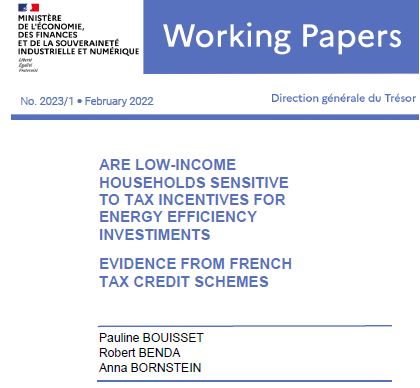Are low-income households sensitive to tax incentives for energy efficiency investments?
The 2015 tax credit rate increase on renovation investments has lead to a larger proportion of low-income households to renovate. The impact of this reform increases, among low-income households, with income, with the size and the age of the dwelling, and is larger for owners of single household dwelling units.
The Working Paper series presents work carried out within DG Treasury, disseminated with the aim of enlightening and stimulating public debate. The authors are solely responsible for their work
This paper assesses the impact of the increase in tax credit rate implemented in France on September 1, 2014 on low-income households’ renovation investments. The transition from the CIDD to the CITE increased the tax credit rate by 5 to 30 percentage points (ppt), depending on households’ income and on the type and number of eligible renovations undertaken (i.e., a single renovation item or a combination of items from a schedule). In particular, this study focuses on the effect of the 15 ppt increase (from 15 to 30%) in the tax credit rate on low-income households’ decision to renovate, on the one hand, and on the amounts they invested, on the other hand. Using a Regression Discontinuity Design model, the 15 ppt tax credit rate increase for low-income households was found to have a statistically significant and positive effect on the probability to renovate, which increases by 1.3 ppt (from an average renovation rate of 1.4% before the reform). We also investigate the potential heterogeneity in the treatment effect on this probability. We find that owners of single household dwelling units, larger dwellings and older dwellings are more sensitive to the tax credit rate increase. The impact of the reform also increases with income (among low-income households). Results on the intensive margin (i.e the additional amount spent by households on energy efficiency investments) show that the reform increases the level of investment by 26% (+€970). However, this result depends on the selected treatment group: when we restrict the sample to households undertaking only one renovation item (before and after the reform – as opposed to a combination of two or more after), the effect on the amount of renovation expenditures is no longer statistically significant, while the effect on the decision to renovate remains significant.
Overall, we show that the increase in tax credit rate for renovation investments in 2015 increased the probability for low-income households to undertake renovation work for two or more eligible items, thus increasing their average total amount of investment, but did not encourage them to carry out more costly single-item renovations.
